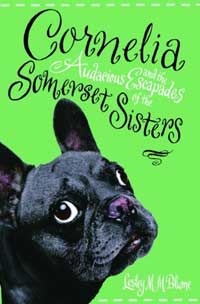Author Lesley M. M. Blume Lives Inside Her Imagination
Authoress Lesley M. M. Blume is nothing short of a verbile logolept, which isn’t as bad as it sounds. Simply put, she’s captivated and most easily inspired by words. A fitting description for Blume, who’s own love of parisology helped fashion her debut literary creation Cornelia Street Englehart, a precocious girl with an appetite for delightfully complicated words in Cornelia and the Audacious Escapades of the Somerset Sisters.
“I, like Cornelia, love words and I’m a relentless nerd about them still,” Blume confessed. “I get e-mails from Dictionary.com everyday and I’m always looking for delicious little things to drop into conversation.”

Each chapter is drenched in words like logolept and verbile, and was inspired not only by ambiguous language, also known as parisology, but by a true British adventuress and friend of Blume’s.
“The idea came about from actually quite a sad story,” Blume said. “An acquaintance of mine who was wild, very beautiful, very brave and very off the beaten path, passed away from leukemia at 27.”
“I was thinking about her and kept hearing these children running up and down the hallway,” she continued. “I remember thinking if you were sick, would that sound be consoling to you? And that’s how [Cornelia and Virginia] came about.”
A New York City native herself, Blume set the story in a charming brownstone in Greenwich Village. There, 11-year-old Cornelia, a terribly lonely girl and the daughter of a non-stop touring concert pianist, meets Virginia Somerset, a writer and expert in global gallivanting.
The two form an instant bond over afternoons filled with mint tea and colorful stories of Virginia’s past.
“Virginia is really for me a wish figure,” Blume explained. “Somebody who breathes every quality that you admire — adventurous, kind, gloriously educated, everything you would want to be an influence early in life.”
Both characters are pure invention, and yet they and many scenes are touched by Blume’s childhood memories. Blume’s mother was also a concert pianist and friend of several eccentric characters that inspired many chapters.
“The dearest parts to me were the New York scenes,” she said. “They were very personal [and] just a window into what their life is like, filled with all of these artists who are so talented, but so egotistical. It’s a very peculiar environment for a kid and it was wonderful for me to remember what that was like.”
Guilty of actually howling like a dog when her mother’s opera-singing friend would visit like Cornelia, Blume also incorporated experiences later in life working for ABC News “Nightline.” It was inevitable her countless travel logs and news reports would later inspire the Somerset sisters.
“I was very frustrated with work, very burnt out from years [of] doing a very intense news cycle,” Blume said. “It’s liberating and a wonderful spin on journalism for me to combine truth and fiction. Draw on experiences, characters in my real life and put them in a fictional format.”
Although writing about Cornelia was a refreshing change, Blume was not willing to abandon her news training entirely. She writes creative fiction on the brink of reporting.
“Being a full-time reporter you don’t bend facts,” she said. “It’s very important to have as much basis as possible when you have a non-fictional character in fiction, because otherwise [readers] might not trust your narrator.”

Blume tried to make each scene plausible, weaving authenticity in and around her fictional storyline. She researched and spent time fact checking even Queen Elizabeth’s history of dog breeding so the infamous Somerset exploit at the Royal Dog show would be believable.
“I just love the idea that a real character can appear in a work of fiction, and I like having a lot of magical realism in my work,” she said.
Shifting from fact to fiction was quite effortless for Blume, who wowed publishers with the very first version of her manuscript.
“I went about it very naïvely,” she confessed. “I had an idea and just decided to write it. It was subject matter that was very dear to me, and that made the transition a lot easier.”
With a background that even includes training for war reporting, Blume’s career change into children’s literature may seem unlikely, but she has her reasons.
“I just think kids are extremely sophisticated, they call shots like they see it,” Blume said. “I really admire that and it’s very refreshing to write for that audience.”
Her next book titled, The Rising Star of Rusty Nail, is set in a small, cornfield town on the border of Iowa and Minnesota and is about a young piano prodigy, Franny Hansen, who was directly inspired by her mother.
“My mom had this gorgeous childhood,” Blume said. “She played in cornfields and the people she grew up with, you can’t make these people up. It was a childhood that I very much enjoyed spending time inside.”
Often children with a real talent see it as more of a hindrance than a blessing, according to Blume. The story of Franny depicts that struggle and what can happen when a musically inclined Russian woman enters the picture and stirs up a stubborn town.
“She has this amazing gift and there’s no way for her to develop it,” Blume said. “Nobody understands it and nobody welcomes it until this Russian woman moves to town who can forward that talent.”
Set in the 1950s, the story touches on deep topics like witch hunting and pursuing the American dream, but Blume reassures readers it is not as heavy as it sounds.
“It’s actually really absurd in a way that only a small-town book can be,” she said. “It’s very funny, very peculiar and it’s very special to me too, because it immortalizes a childhood of my mother’s. I’m very fond of it.”
Blume is currently finishing her third work of fiction, about an elite southern family that is dealing with complicated legacies and a dwindling fortune during the Depression.
“It has humor in it, but it’s a very dark book,” Blume said. “It takes place in flashbacks during the Civil War [as] this family tries to reconcile the fact that their position in society was based on something very bloody and horrible — slavery.”
Naturally, Blume jumped right into researching the topic, sculpting an imaginative, yet believable world by spending time on Louisiana plantations and even in a haunted antebellum mansion.
But despite her haunting experience, Blume still enjoys every minute of her job.
“I really love doing this. I really do,” she said. “Basically, my editor has commissioned me to live inside my imagination. I feel like I do see things in a relatively unique way and to channel that into fiction has just been incredibly rewarding.”
As she continues to think of future escapades, Blume has one simple goal in mind.
“Have the writing be intelligent, let it say something to people, and let it be memorable,” she said.
In the words of Cornelia Street Englehart, that sounds positively galumptious Ms. Blume.
For more on Lesley M.M. Blume, be sure to visit her official website – LesleyMMBlume.com.
Recommend0 recommendationsPublished in Features, Publishing



Responses